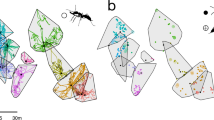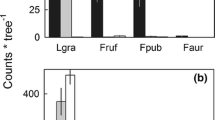Abstract
New World army ants (Ecitoninae) are nomadic group-predators that are widely thought to have a substantial impact on their prey. Nevertheless, quantitative data on prey intake by army ants is scarce and mostly limited to chance encounters. Here, I quantify the prey intake of the army ant Eciton hamatum at the contrasting scales of raid, colony (sum of simultaneous raids), and population. Like most army ants, E. hamatum conducts narrow ‘column raids’ and has a specialized diet of ant prey. I show that individual raids often had periods of no prey intake, and raid intake rates, calculated in g/min, differed significantly among colonies. Moreover, neither mean nor peak raid intake rates were correlated with colony size. Similarly, colony intake rates differed significantly among colonies, and mean colony intake rates were not correlated with colony size. However, mean colony intake rates were significantly higher than mean raid intake rates, and peak colony intake rate was correlated with colony size. Having multiple raids thus improves colony-level intake rates, and larger colonies can harvest more prey per unit time. Mean colony intake rate across colonies was 0.067 g/min dry weight and mean daily colony intake was calculated at 38.2 g. This intake is comparable to that of Eciton burchellii, which has a more generalized diet and conducts spectacular ‘swarm raids’ that are seen as having a greater impact on prey than column raids. Population size on Barro Colorado Island, Panama, was estimated to be 57 colonies, which extrapolates to a daily population intake of nearly 2 kg of prey dry weight, or 120 g/km2. Broadly, these findings demonstrate that column raiding army ants experience considerable variation in prey intake for individual raids, but can still achieve notable impact at the larger scales of colony and population. Furthermore, they challenge the idea that swarm-raiding species necessarily have greater intake and thus impact on prey. Instead, I suggest that conducting multiple column raids may be a strategy that allows for comparable intake from a more specialized diet.


Similar content being viewed by others
References
Belt T. 1874. The Naturalist in Nicaragua. John Murray, London. 442 pp
Breton J.L., Dejean A., Snelling G. and Orivel J. 2007. Specialized predation on Wasmannia auropunctata by the army ant species Neivamyrmex compressinodis. J. Appl. Entomol. 131: 740–743
Cherrett J.M. and Peregrine D.J. 1976. A review of the status of leaf-cutting ants and their control. Ann. Appl. Biol. 84: 124–128
Cherrett J. 1986. The economic importance and control of leaf-cutting ants. In Economic Impact and Control of Social Insects (Vinson S.B., Ed) Praeger, New York. pp 165–192
Darwin C. 1839. Journal of Researches into the Natural History and Geology of the Countries visited during the Voyage of the H. M. S. ‘Beagle’ round the World, under the Command of Capt. Fitz Roy, R. N. Henry Colburn, London. 551 pp
Franks N.R. 1982a. A new method for censusing animal populations: the number of Eciton burchelli army ant colonies on Barro Colorado Island, Panama. Oecologia 52: 266–268
Franks N.R. 1982b. Ecology and population regulation in the army ant Eciton burchelli. In: The Ecology of a Tropical Forest: Seasonal Rhythms and Long-Term Changes (Leigh E.G., Rand A.S. and Windsor D.M., Eds), Oxford University Press, Oxford. pp 389–395
Franks N.R. 1985. Reproduction, foraging efficiency and worker polymorphism in army ants. In: Experimental Behavioral Ecology and Sociobiology: in Memoriam Karl von Frisch, 1886-1982 (Hölldobler B. and Lindauer M., Eds), Sinauer Associates, Sunderland Massachusetts. pp 91–107
Franks N.R. 1980. The evolutionary ecology of the army ant Eciton burchelli on Barro Colorado Island, Panama. Ph.D. dissertation, The University of Leeds, Leeds, England. pp 242
Franks N.R. and Bossert W.H. 1983. The influence of swarm raiding army ants on the patchiness and diversity of a tropical leaf litter ant community. In: Tropical Rain Forest: Ecology and Management. Special Publication of the British Ecological Society No. 2 (Sutton S.L., Whitmore T.C. and Chadwick A.C., Eds), Blackwell Scientific Publications, Oxford. pp 151–163
Hölldobler B. and Wilson E.O. 1990. The Ants. Harvard University Press, Cambridge Massachusetts. pp. 752
Kaspari M. and O’Donnell S. 2003. High rates of army ant raids in the Neotropics and implications for ant colony and community structure. Evol. Ecol. Res. 5: 933–939
Lach L., Parr C.L. and Abbott K.L. 2010. Ant Ecology. Oxford University Press, Oxford. pp 432
LaPolla J.S., Mueller U.G., Seid M. and Cover S.P. 2002. Predation by the army ant Neivamyrmex rugulosus on the fungus-growing ant Trachymyrmex arizonensis. Insect. Soc. 49: 251–256
Leigh E.G. 1999. Tropical Forest Ecology: a View from Barro Colorado Island. Oxford University Press, USA. pp 264
O’Donnell S., Lattke J., Powell S. and Kaspari M. 2007. Army ants in four forests: geographic variation in raid rates and species composition. J. Anim. Ecol. 76: 580–589
Otis G.W., Santana C.E., Crawford D.L. and Higgins M.L. 1986. The effect of foraging army ants on leaf-litter arthropods. Biotropica 18: 56–61
Powell S. and Clark E. 2004. Combat between large derived societies: a subterranean army ant established as a predator of mature leaf-cutting ant colonies. Insect. Soc. 51: 342–351
Powell S. and Franks N.R. 2006. Ecology and the evolution of worker morphological diversity: a comparative analysis with Eciton army ants. Funct. Ecol. 20: 1105–1114
Rettenmeyer C.W. 1963. Behavioral studies of army ants. Univ. Kans. Sci. Bull. 44: 281–465
Rettenmeyer C.W., Chadab-Crepet R., Naumann M.G. and Morales L. 1983. Comparative foraging by neotropical army ants. In: Social Insects in the Tropics. Volume 2 (Jaisson P., Ed). Université Paris-Nord, Paris. pp 59–73
Rico-Gray V. and Oliveira P.S. 2007. The Ecology and Evolution of Ant-Plant Interactions. University of Chicago Press, Chicago. 320 pp
Schneirla T.C. 1971. Army Ants. A Study in Social Organization (Topoff H.R., Ed). W.H. Freeman and Co., San Francisco. pp 369
Schneirla T.C. 1949. Army-ant life and behavior under dry-season conditions. 3. The course of reproduction and colony behavior. Bull. Am. Mus. Nat. His. 94: 3–81
Schneirla T.C. 1955. The army ants. Rep. Smith. Inst. 1955: 379–406
Swartz M.B. 1998. Predation on an Atta cephalotes colony by an army ant Nomamyrmex esenbecki. Biotropica 30: 682–684
Teles Da Silva M. 1982. Behaviour of army ants Eciton burchelli and E. hamatum (Hymenoptera, Formicidae) in the Belem region III. Raid activity. Insect. Soc. 29: 243–267
Vidal-Riggs J.M. and Chaves-Campos J. 2008. Method review: estimation of colony densities of the army ant Eciton burchellii in Costa Rica. Biotropica 40: 259–262
Wetterer J.K., Gruner D.S. and Lopez J.E. 1998. Foraging and nesting ecology of Acromyrmex octospinosus (Hymenoptera: Formicidae) in a Costa Rican tropical dry forest. Fla. Entomol. 81: 61–67
Wheeler G.C. and Wheeler J. 1976. Ant larvae: review and synthesis. Mem. Entomol. Soc. Wash. 7: 1–108
Wheeler W.M. 1910. Ants: their Structure, Development and Behavior. The Columbia University Press, New York. pp 663
Acknowledgments
This manuscript is dedicated to Carl W. Rettenmeyer. His positive influence on my career and life are immeasurable. I also thank Ellie Clark, Egbert G. Leigh Jr., and William T. Wcislo for valuable discussion, as well as the staff of the Smithsonian Tropical Research Institute for logistical support. This research was funded primarily by a Short-Term Fellowship from the Smithsonian Tropical Research Institute, Panama, with additional support from Carl Rettenmeyer.
Author information
Authors and Affiliations
Corresponding author
Rights and permissions
About this article
Cite this article
Powell, S. How much do army ants eat? On the prey intake of a neotropical top-predator. Insect. Soc. 58, 317–324 (2011). https://doi.org/10.1007/s00040-011-0152-3
Received:
Revised:
Accepted:
Published:
Issue Date:
DOI: https://doi.org/10.1007/s00040-011-0152-3




